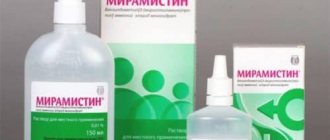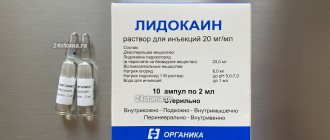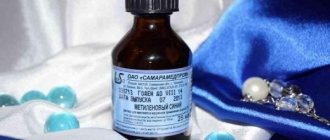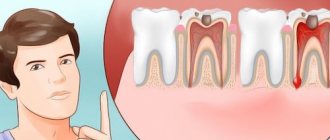Nosological classification (ICD-10)
- B37.9 Candidiasis, unspecified
- J02.9 Acute pharyngitis, unspecified
- J03.9 Acute tonsillitis, unspecified (angina agranulocytic)
- J04.0 Acute laryngitis
- J37.0 Chronic laryngitis
- K05 Gingivitis and periodontal diseases
- K05.4 Periodontal disease
- K11.8 Other diseases of the salivary glands
- K12 Stomatitis and related lesions
- K14.0 Glossitis
- Z01.2 Dental examination
- Z100* CLASS XXII Surgical practice
Side effects
Rarely, the drug may cause the following undesirable effects:
- burning or numbness at the injection site;
- nausea or stomach pain;
- dry mouth mucous membranes;
- excess salivation;
- increased heart rate;
- dizziness or headache;
- Quincke's edema;
- diarrhea;
- noise in ears;
- allergic dermatoses;
- drowsiness;
- laryngospasm;
- confusion.
Such manifestations indicate individual intolerance to the drug.
Composition and release form
| Lozenges | 1 table |
| benzydamine hydrochloride | 3 mg |
| excipients: isomaltose; racementol; aspartame; citric acid monohydrate; mint flavor; lemon flavoring; quinoline yellow dye (E104); indigo carmine dye (E132) |
in a package there are 10 tablets, each of which is wrapped in waxed paper, placed in a wrapper made of two-layer aluminum foil; in a cardboard pack 2 packages (wrappers).
| Solution for topical use 0.15% | 100 ml |
| benzydamine hydrochloride | 0.15 g |
| excipients: ethanol 96%; glycerin (glycerol); methyl parahydroxybenzoate; menthol flavoring; saccharin; sodium bicarbonate; polysorbate 20; quinoline yellow dye 70% (E104); patented blue dye 85% (E131); purified water |
in bottles of 120 ml; complete with measuring cup; 1 set in a cardboard pack.
| Topical spray dosed 0.255 mg/dose | 100 ml |
| benzydamine hydrochloride | 0.15 g |
| excipients: ethanol 96%; glycerol; methyl parahydroxybenzoate; menthol flavoring (flavoring additive); saccharin; sodium bicarbonate; polysorbate 20; purified water |
in bottles equipped with a pump and a pressure device with a folding cannula of 30 ml; 1 bottle in a cardboard pack.
Compound
Tantum Verde perfectly relieves any catarrh in the oral cavity and facilitates its progression thanks to its active component - benzydamine hydrochloride. The product is used for a number of ailments of the mouth or throat. Such diseases are:
- fungal infections;
- ulcers of the oral mucosa after radiation or chemotherapy;
- in the postoperative period (after removal of tonsils or teeth), in the treatment of jaw fractures;
- gingivitis with bleeding;
- candidiasis;
- tonsillitis;
- tonsillitis;
- pharyngitis;
- laryngitis;
- periodontal disease;
- catarrh of the salivary glands and tongue.
How can one explain such a high effectiveness of this medicine? This non-steroidal anti-inflammatory drug is indispensable in ENT practice, dentistry and maxillofacial surgery. Its therapeutic effect is determined by the ideally selected medicinal composition and excellent absorption of the drug with a minimum of negative effects. Tantum Verde includes:
- benzydamine hydrochloride (main active ingredient);
- racementol;
- isomaltose;
- lemon acid,
- indigo carmine;
- alcohol;
- excipients: flavorings (lemon or mint), citric acid, dyes (E 104 and E 131), saccharin, distilled water.
The drug is available in the form:
- lozenges;
- spray;
- solution for topical use.
Any form of Tantum Verde has the following therapeutic effects:
- pain reliever (negates pain symptoms 15 seconds after use);
- anti-inflammatory (ulcers and erosions with stomatitis are extremely painful, and this remedy acts specifically in the inflammatory focus, without affecting the healthy mucosa);
- antiseptic (slows down the reproduction processes and leads to the death of infectious agents);
- antifungal (destroys fungal colonies).
Pharmacodynamics
Benzidamine is a non-steroidal anti-inflammatory drug that belongs to the indazoles group. It has an anti-inflammatory and local analgesic effect, and has an antiseptic effect against a wide range of microorganisms.
The mechanism of action of the drug is associated with the stabilization of cell membranes and inhibition of PG synthesis.
Benzidamine has an antibacterial and specific antimicrobial effect due to rapid penetration through the membranes of microorganisms with subsequent damage to cellular structures, disruption of metabolic processes and cell lysis.
Has antifungal effect against Candida albicans. Causes structural modifications of the cell wall of fungi and the metabolic chains of mycetes, thus preventing their reproduction, which is the basis for the use of benzydamine for inflammatory processes in the oral cavity, including infectious etiology.
When the remedy is ineffective
Often active advertising and the affordable price of a medicine lead to unpleasant phenomena, provoking self-medication.
The use of Tantum Verde for catarrh of the respiratory tract (tracheitis or bronchitis) is not justified. Here the remedy may even be harmful, spasming the bronchioles and causing suffocation.
Use this product with caution in children under 3 years of age.
In a number of instructions, not a single form of the drug is used for young children. However, the prescription of the drug is quite frequent even at this age, since it copes well with many problems in the mouth (in the absence of contraindications and the rules for using the drug are followed).
Until the age of 12, do not use an undiluted solution of the drug for rinsing.
During pregnancy and the lactation period, in some cases, topical use of the product in the form of a spray or solution is allowed.
Tantum Verde tablets are contraindicated for pregnant and nursing mothers.
Any use of Tantum Verde for nursing mothers and pregnant women is decided by the doctor.
Indications for Tantum® Verde
Inflammatory diseases of the oral cavity and ENT organs (of various etiologies):
gingivitis, glossitis, stomatitis (including after radiation and chemotherapy);
sore throat, pharyngitis, laryngitis, tonsillitis;
candidiasis (as part of combination therapy);
calculous inflammation of the salivary glands;
after surgical interventions and injuries (tonsillectomy, jaw fractures, etc.);
after treatment or tooth extraction;
periodontal disease.
For infectious and inflammatory diseases requiring systemic treatment, it is necessary to use Tantum® Verde as part of combination therapy.
Reasons contributing to the development of aphthous stomatitis
- Injuries to the oral cavity (mechanical, thermal, chemical).
- Inflammatory diseases of the teeth and nasopharynx: caries, periodontitis, gingivitis, tonsillitis, sinusitis, pharyngitis.
- Treatment with cytostatics and radiation therapy for cancer.
- Low quality dentures.
- Neglect of oral hygiene standards.
- AIDS.
- Pregnancy period and menopause in women due to hormonal imbalance.
- Diseases of the digestive system.
- Allergies of various origins (food, medication, microbial).
- Lack of complete proteins, vitamins B, C, folic acid, macroelements selenium, zinc in the diet.
- Diseases that cause depletion of the body (tuberculosis).
- Abuse of strong alcoholic drinks, smoking.
The symptoms of aphthous stomatitis in adults are determined by the pathogen, the general state of local and general immunity, and concomitant diseases.
- Acute aphthous stomatitis begins with fever, weakness, and headache. Regional lymph nodes are enlarged. Hyperemic round or oval spots appear on the oral mucosa, slightly rising above the surface. Then the areas of hyperemia become ulcerated. Erosions are painful, pain not only when chewing, but also at rest. Some erosions are covered with fibrin films. The plaque is tightly fused to the underlying tissues; when you try to remove it, the surface bleeds. Erosions are located singly on the mucous membrane of the lips, cheeks, and lateral surfaces of the tongue.
- Chronic aphthous stomatitis is formed either with inadequate treatment of the acute form of aphthous stomatitis, or with a significant decrease in general immunity. It is characterized by a cyclical course: periods of exacerbation are replaced by remission.
- Necrotic form of aphthous stomatitis. Not only the mucous membrane is affected, but also the submucosal layer. Tissue necrobiosis occurs. Aphthae are deep and their characteristic feature is painlessness. It is observed in debilitated patients with a sharp decrease in general immunity (AIDS, tuberculosis, cancer, blood diseases, severe infectious diseases). The healing period extends from 2 weeks to a month.
- Grandular - aphthae lie at the mouths of the minor salivary glands. Salivation is impaired. Relapse can occur after acute respiratory viral infections, with exacerbation of foci of chronic infection.
- The scarring form of aphthous stomatitis affects young people. The genetic factor of insufficiency of the secretory apparatus of the salivary glands plays a role. Aphthae capture not only the mucous membrane in the area of the terminal salivary sections, but also the underlying connective tissue. The ulcers are painful and reach 1.5 cm in diameter. Dissipated throughout the mucous membrane of the pharynx and anterior palatine arches. The healing process continues for up to 3 months, leaving scars.
- Deforming form of aphthous stomatitis. Due to the destruction of connective tissue and subsequent scar healing, the architecture of the oral cavity is disrupted.
Directions for use and doses
Locally. Lozenges: 1 tablet. 3–4 times a day. The tablet must be kept in the mouth until completely dissolved (for greater effect, preferably for as long as possible).
Solution for topical use: for gargling or mouthwash, use 15 ml of the drug (measuring cup included) 2-3 times a day.
An undiluted solution is used for rinsing during inflammatory processes; a diluted solution (15 ml of the drug and 15 ml of water mixed in a measuring cup) should be used daily for hygienic rinsing of the mouth and throat.
Topical spray dosed at 0.255 mg/dose: adults and elderly patients are prescribed 4-8 doses every 1.5-3 hours.
Children aged 6–12 years - 4 doses; 3-6 years - 1 dose for every 4 kg of body weight (maximum - 4 doses) every 1.5-3 hours.
Important benefits of use
Under the name "Tantum Verde" they produce several forms of a medicine made in Italy. These include:
- An undiluted 0.15% solution instantly provides relief from various catarrhal phenomena: soreness in the mucous membranes of the throat and mouth is eliminated, swelling of soft tissues is relieved, coughing is reduced, and purulent plugs from the tonsils are dissolved. In diluted form, it is used for the prevention of post-operative or post-traumatic complications (tooth extraction, tonsillectomy, jaw injuries).
- The tablet form is effective for acute or chronic catarrh of the mouth and throat, when the mucous membrane is swollen, painful and loose throughout. The tablets help relieve inflammation, soothe a sore throat and eliminate many of the patient’s sufferings.
- The spray is considered the ideal form of the product, penetrating deeply into the soft tissues of the throat for sore throat, stomatitis, pharyngitis or laryngitis. Ideal for children who do not yet know how to gargle or dissolve tablets. Allows you to clearly influence the source of inflammation.
Contraindications
It is important to carefully study the instructions before purchasing this medicine . Its use is unacceptable in the following cases:
- individual negative reaction to the drug;
- phenylketonuria;
- peptic ulcer in the acute stage:
- obstructive pulmonary diseases;
- heart failure;
- severe bronchial asthma.
Features of use for children
In children, stomatitis brings especially much suffering. The child’s sleep and appetite suffer, and the temperature rises. This remedy anesthetizes all wounds and ulcers in the mouth. In addition, it stimulates local cellular immunity, preventing the reappearance of various post-infectious complications. It is also important that this product is considered hypoallergenic and has a minimum of contraindications and side effects.
If the mucous membranes of the throat and mouth are sore in children, it is important that within 15 seconds after use Tantum Verde will relieve local pain for half an hour.
A particularly convenient form for children is a spray. While the child learns to gargle or figures out how to dissolve a tablet, this type of Tantum Verde will really help him quickly and easily.
Treatment of a child’s mouth with the drug should not exceed the frequency of “once every 3-4 hours.” The baby should not take the medicine for a long time. In this case, Tantum Verde can cause problems in the form of rashes, bleeding gums and even anemia.
It is prohibited to exceed the dosage of the drug for children. The following calculation of the optimal dose is usually recommended: for every 4 kg of the child’s weight – 1 dose of spray.
It is especially dangerous to use the medicine for children without medical advice.
Tantum Verde has established itself as an effective remedy for stomatitis, capable in a short time of not only numbing unbearable pain, but also eliminating the cause of the disease, bringing the patient closer to full recovery. Be healthy!
Sources used:
- Medicines in dentistry / I.K. Lutskaya. - Moscow
- Teeth are forever healthy and beautiful / Maren von Pluta. - M.: Sigma-press, 1997.
- https://health.mail.ru/drug/tantum_verde/










